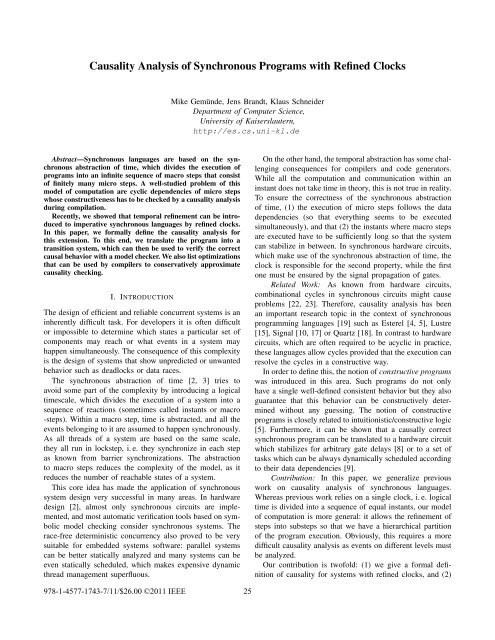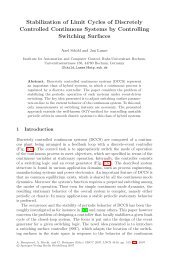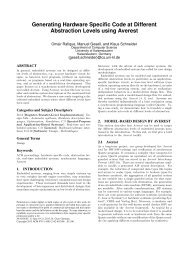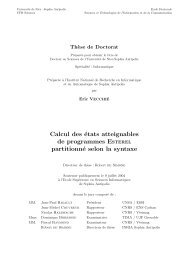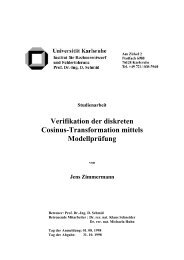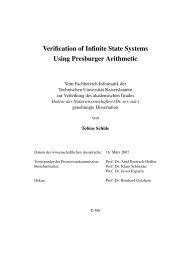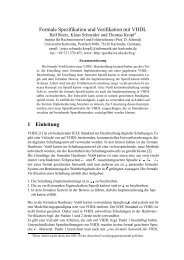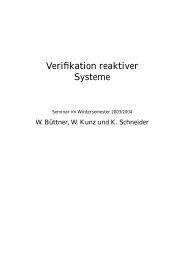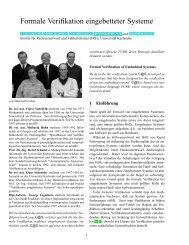Causality Analysis of Synchronous Programs with Refined Clocks
Causality Analysis of Synchronous Programs with Refined Clocks
Causality Analysis of Synchronous Programs with Refined Clocks
You also want an ePaper? Increase the reach of your titles
YUMPU automatically turns print PDFs into web optimized ePapers that Google loves.
<strong>Causality</strong> <strong>Analysis</strong> <strong>of</strong> <strong>Synchronous</strong> <strong>Programs</strong> <strong>with</strong> <strong>Refined</strong> <strong>Clocks</strong><br />
Mike Gemünde, Jens Brandt, Klaus Schneider<br />
Department <strong>of</strong> Computer Science,<br />
University <strong>of</strong> Kaiserslautern,<br />
http://es.cs.uni-kl.de<br />
Abstract—<strong>Synchronous</strong> languages are based on the synchronous<br />
abstraction <strong>of</strong> time, which divides the execution <strong>of</strong><br />
programs into an infinite sequence <strong>of</strong> macro steps that consist<br />
<strong>of</strong> finitely many micro steps. A well-studied problem <strong>of</strong> this<br />
model <strong>of</strong> computation are cyclic dependencies <strong>of</strong> micro steps<br />
whose constructiveness has to be checked by a causality analysis<br />
during compilation.<br />
Recently, we showed that temporal refinement can be introduced<br />
to imperative synchronous languages by refined clocks.<br />
In this paper, we formally define the causality analysis for<br />
this extension. To this end, we translate the program into a<br />
transition system, which can then be used to verify the correct<br />
causal behavior <strong>with</strong> a model checker. We also list optimizations<br />
that can be used by compilers to conservatively approximate<br />
causality checking.<br />
I. INTRODUCTION<br />
The design <strong>of</strong> efficient and reliable concurrent systems is an<br />
inherently difficult task. For developers it is <strong>of</strong>ten difficult<br />
or impossible to determine which states a particular set <strong>of</strong><br />
components may reach or what events in a system may<br />
happen simultaneously. The consequence <strong>of</strong> this complexity<br />
is the design <strong>of</strong> systems that show unpredicted or unwanted<br />
behavior such as deadlocks or data races.<br />
The synchronous abstraction <strong>of</strong> time [2, 3] tries to<br />
avoid some part <strong>of</strong> the complexity by introducing a logical<br />
timescale, which divides the execution <strong>of</strong> a system into a<br />
sequence <strong>of</strong> reactions (sometimes called instants or macro<br />
-steps). Within a macro step, time is abstracted, and all the<br />
events belonging to it are assumed to happen synchronously.<br />
As all threads <strong>of</strong> a system are based on the same scale,<br />
they all run in lockstep, i. e. they synchronize in each step<br />
as known from barrier synchronizations. The abstraction<br />
to macro steps reduces the complexity <strong>of</strong> the model, as it<br />
reduces the number <strong>of</strong> reachable states <strong>of</strong> a system.<br />
This core idea has made the application <strong>of</strong> synchronous<br />
system design very successful in many areas. In hardware<br />
design [2], almost only synchronous circuits are implemented,<br />
and most automatic verification tools based on symbolic<br />
model checking consider synchronous systems. The<br />
race-free deterministic concurrency also proved to be very<br />
suitable for embedded systems s<strong>of</strong>tware: parallel systems<br />
can be better statically analyzed and many systems can be<br />
even statically scheduled, which makes expensive dynamic<br />
thread management superfluous.<br />
On the other hand, the temporal abstraction has some challenging<br />
consequences for compilers and code generators.<br />
While all the computation and communication <strong>with</strong>in an<br />
instant does not take time in theory, this is not true in reality.<br />
To ensure the correctness <strong>of</strong> the synchronous abstraction<br />
<strong>of</strong> time, (1) the execution <strong>of</strong> micro steps follows the data<br />
dependencies (so that everything seems to be executed<br />
simultaneously), and that (2) the instants where macro steps<br />
are executed have to be sufficiently long so that the system<br />
can stabilize in between. In synchronous hardware circuits,<br />
which make use <strong>of</strong> the synchronous abstraction <strong>of</strong> time, the<br />
clock is responsible for the second property, while the first<br />
one must be ensured by the signal propagation <strong>of</strong> gates.<br />
Related Work: As known from hardware circuits,<br />
combinational cycles in synchronous circuits might cause<br />
problems [22, 23]. Therefore, causality analysis has been<br />
an important research topic in the context <strong>of</strong> synchronous<br />
programming languages [19] such as Esterel [4, 5], Lustre<br />
[15], Signal [10, 17] or Quartz [18]. In contrast to hardware<br />
circuits, which are <strong>of</strong>ten required to be acyclic in practice,<br />
these languages allow cycles provided that the execution can<br />
resolve the cycles in a constructive way.<br />
In order to define this, the notion <strong>of</strong> constructive programs<br />
was introduced in this area. Such programs do not only<br />
have a single well-defined consistent behavior but they also<br />
guarantee that this behavior can be constructively determined<br />
<strong>with</strong>out any guessing. The notion <strong>of</strong> constructive<br />
programs is closely related to intuitionistic/constructive logic<br />
[5]. Furthermore, it can be shown that a causally correct<br />
synchronous program can be translated to a hardware circuit<br />
which stabilizes for arbitrary gate delays [8] or to a set <strong>of</strong><br />
tasks which can be always dynamically scheduled according<br />
to their data dependencies [9].<br />
Contribution: In this paper, we generalize previous<br />
work on causality analysis <strong>of</strong> synchronous languages.<br />
Whereas previous work relies on a single clock, i. e. logical<br />
time is divided into a sequence <strong>of</strong> equal instants, our model<br />
<strong>of</strong> computation is more general: it allows the refinement <strong>of</strong><br />
steps into substeps so that we have a hierarchical partition<br />
<strong>of</strong> the program execution. Obviously, this requires a more<br />
difficult causality analysis as events on different levels must<br />
be analyzed.<br />
Our contribution is tw<strong>of</strong>old: (1) we give a formal definition<br />
<strong>of</strong> causality for systems <strong>with</strong> refined clocks, and (2)<br />
978-1-4577-1743-7/11/$26.00 ©2011 IEEE 25
we list conservative approximations to quickly check the<br />
causality <strong>of</strong> a system at compile-time.<br />
Outline: The rest <strong>of</strong> the paper is structured as follows:<br />
Section II presents the basic notions <strong>of</strong> imperative<br />
synchronous programs and introduces the concept <strong>of</strong> clock<br />
refinement. Section III presents the first part <strong>of</strong> our contribution:<br />
we define causality in the context <strong>of</strong> clock refinement,<br />
and reduce it to a model checking problem. Section IV<br />
contains the second part <strong>of</strong> our contribution: conservative approximations<br />
which can be used by compilers to efficiently<br />
check causality. Finally, Section V concludes <strong>with</strong> a short<br />
summary.<br />
II. CLOCK REFINEMENT<br />
A. Clock Refinement in Imperative <strong>Synchronous</strong> Languages<br />
The synchronous model <strong>of</strong> computation [3, 14] divides the<br />
execution <strong>of</strong> a program into a sequence <strong>of</strong> macro steps [16]<br />
(also called reactions). In each <strong>of</strong> these steps, the system<br />
reads the inputs, performs some computation and finally<br />
produces the outputs. In theory, the outputs appear the same<br />
instant when the inputs are read. In practice, the execution<br />
implicitly follows the data dependencies between the micro<br />
steps, and outputs are computed fast enough for the given<br />
application.<br />
Imperative synchronous languages implement this model<br />
<strong>of</strong> computation by means <strong>of</strong> the pause statement. While<br />
all other primitive statements do not take time, a pause<br />
marks the end <strong>of</strong> a reaction and is therefore responsible for<br />
consuming one unit <strong>of</strong> logical time. Thus, a reaction consists<br />
<strong>of</strong> all actions (or assignments) between two consecutive<br />
pause statements.<br />
As already stated in the introduction, all threads are based<br />
on the same timescale and therefore, synchronize at each<br />
pause statement – even if they do not communicate. This<br />
so-called over-synchronization is an undesired side-effect <strong>of</strong><br />
the synchronous model <strong>of</strong> computation.<br />
While many solutions exist to overcome this problem<br />
(clock sampling in Lustre, polychrony in Signal, multi-clock<br />
extensions in Esterel), we focus on clock refinement in the<br />
following. This extension was recently proposed [12] to<br />
avoid over-synchronization and other undesired effects in<br />
synchronous languages. Its basic idea will be illustrated<br />
in the following <strong>with</strong> the help <strong>of</strong> two implementations <strong>of</strong><br />
the Euclidean Algorithm to compute the greatest common<br />
divisor (GCD).<br />
The first variant, which is given on the left-hand side <strong>of</strong><br />
Figure 1, does not use clock refinement. The module reads<br />
its two inputs a and b in the first step and assigns them<br />
to the local variables x and y. Then, the module computes<br />
iteratively the GCD <strong>of</strong> the local variables. The computation<br />
steps are separated by the pause statement <strong>with</strong> label<br />
l. Each variable has one value per step and the delayed<br />
assignments in form <strong>of</strong> the next statements assigns a new<br />
value to the variables for the following step. Finally, the<br />
module GCD1<br />
(nat ?a, ?b, !gcd)<br />
{<br />
}<br />
nat x, y;<br />
x = a;<br />
y = b;<br />
while(x > 0) {<br />
if(x >= y)<br />
next(x) = x−y;<br />
else<br />
next(y) = y−x;<br />
l: pause;<br />
}<br />
gcd = y;<br />
(a) Single Clock<br />
Figure 1.<br />
module GCD2<br />
(nat ?a, ?b, !gcd)<br />
{<br />
clock(C1) {<br />
nat x, y;<br />
x = a;<br />
y = b;<br />
while(x > 0) {<br />
if(x >= y)<br />
next(x) = x−y;<br />
else<br />
next(y) = y−x;<br />
l: pause (C1);<br />
}<br />
gcd = y;<br />
}<br />
}<br />
(b) Clock Refinement<br />
Greatest Common Divisor<br />
GCD is written to the output gcd. Apparently, a drawback<br />
<strong>of</strong> this implementation is that the computation is spread over<br />
a number <strong>of</strong> reactions whose number depends on the input<br />
values, and each call to this module has to take care <strong>of</strong> the<br />
consumption <strong>of</strong> time.<br />
The second variant, shown on the right-hand side <strong>of</strong><br />
Figure 1, makes use <strong>of</strong> clock refinement. While the overall<br />
algorithm is the same, the time required for the GCD<br />
computation is now hidden by a declaration <strong>of</strong> a local<br />
clock. The computation steps are separated by the pause<br />
statement <strong>with</strong> label l, which now belongs to the clock<br />
C1. In contrast to the first variant, the computation does<br />
not hit a pause statement <strong>of</strong> the outer clock and thus,<br />
the computation steps are not visible to the outside. As a<br />
consequence, each call to this module seems to be completed<br />
in a single step. The local variables x and y are now declared<br />
inside the local clock block and therefore, they can change<br />
their value for each step <strong>of</strong> the local clock, which is crucial<br />
for the correctness <strong>of</strong> the algorithm.<br />
With local clock declarations, existing clocks can be refined<br />
and arbitrary many abstraction levels can be introduced<br />
to the single-clocked synchronous model. Furthermore, the<br />
extension gives developers some flexibility for desynchronized<br />
implementations through unrelated clock refinements,<br />
i. e. local clocks that are declared in parallel threads. Those<br />
clocks are not visible to each other, and both threads can<br />
proceed independent <strong>of</strong> each other until a synchronization<br />
is enforced by a pause <strong>of</strong> a common clock. Thus, the clock<br />
declarations generally form a tree, and clocks are not visible<br />
outside their local declarations.<br />
In the same way as micro steps are executed <strong>with</strong>in a<br />
macro step, the substeps introduced by a refined clock are<br />
26
executed <strong>with</strong>in a step <strong>of</strong> a higher (slower) clock. As shown<br />
in the example, variables can be declared for sub-clocks<br />
so that they can change their value for every step <strong>of</strong> this<br />
clock. For unrelated clocks, the different substeps are not<br />
synchronized and they can be executed independently only<br />
<strong>with</strong> respect to data dependencies. Since variables at lower<br />
(faster) clock levels are not visible at higher levels, they are<br />
also not visible for unrelated clocks. Thus, communication<br />
between such clocks must take place through variables on<br />
higher levels.<br />
As it can be seen in the example, the module’s clock is<br />
not explicitly declared. We simply refer to this base clock<br />
by C 0 in the rest <strong>of</strong> the paper. In addition, we write C 1 ≻ C 2<br />
if the clock C 2 is declared in the scope <strong>of</strong> C 1 , i. e. C 1 is<br />
on higher level (slower) than C 2 . The relations , ≺, are<br />
used accordingly. If two clocks C 1 and C 2 are independent,<br />
i. e. neither C 1 C 2 nor C 1 C 2 holds, we write C 1 # C 2 .<br />
This may hold if the two clocks are declared in different<br />
threads <strong>of</strong> a parallel statement.<br />
B. <strong>Causality</strong> and Clock Refinement<br />
The semantics <strong>of</strong> synchronous languages requires that all<br />
variables have a unique value in each reaction, and all<br />
executions must be consistent <strong>with</strong> these values. Consider<br />
the module in Figure 2 (a), where in the step between the<br />
two pause statements the variables x and y are assigned,<br />
whereas y is assigned before x in the source code, but<br />
the value <strong>of</strong> y depends on the value <strong>of</strong> x. However, the<br />
variable x has exactly one value for a step, and the value<br />
that is assigned to x must be the same which is used to<br />
calculate the value <strong>of</strong> y. Thus, the program rather gives<br />
a set <strong>of</strong> equations which must be fulfilled for the step.<br />
A second module which is given in Figure 2 (b) also<br />
assigns x and y, and the execution <strong>of</strong> the assignment to<br />
x depends on the value <strong>of</strong> y. Again, there is exactly one<br />
value for each variable and thus, y must be computed before<br />
it can be decided whether x is assigned by 2 ∗ a or not.<br />
Such dependencies are dynamically resolved by hardware<br />
circuits, which should stabilize after some time. However,<br />
one could easily program a cyclic dependency which, when<br />
it is translated to a hardware circuit, eventually oscillates<br />
(and therefore does not stabilize). Such cycles are not desired<br />
and have to be avoided. A lot <strong>of</strong> work has been done in this<br />
field for synchronous languages [1, 9, 19, 21].<br />
The introduction <strong>of</strong> refined clocks introduced some new<br />
kind <strong>of</strong> causality to the synchronous model. We examine<br />
the effects on the example in Figure 3. In the example, two<br />
local clocks, C1 and C2, are declared in two parallel threads.<br />
The threads synchronize on pause statements that belong<br />
to the same clock, that are the statements <strong>with</strong> labels l 3<br />
and l 4 in the example. In between, both threads can do<br />
independent steps for lower clocks. However, the variable<br />
c is declared outside <strong>of</strong> both threads, and is used by both.<br />
The step related to this variable ends <strong>with</strong> the labels l 3 and<br />
module <strong>Causality</strong>1 module <strong>Causality</strong>2<br />
(nat ?a, x, y) (nat ?a, x, y)<br />
{<br />
{<br />
l 1 : pause;<br />
l 1 : pause;<br />
y = a + x;<br />
if (y > 2)<br />
x = 2 ∗ a;<br />
x = 2 ∗ a;<br />
l 2 : pause;<br />
||<br />
}<br />
y = a + 1;<br />
l 2 : pause;<br />
}<br />
(a) <strong>Causality</strong> 1 (b) <strong>Causality</strong> 2<br />
Figure 2.<br />
<strong>Causality</strong> in the <strong>Synchronous</strong> Model<br />
module <strong>Causality</strong>3 (nat ?a, o)<br />
{<br />
nat c;<br />
l 0 : pause;<br />
clock(C1) {<br />
nat x = a;<br />
l 1 : pause(C1);<br />
if(x > 2)<br />
o = c;<br />
else<br />
c = 4;<br />
l 3 : pause;<br />
}<br />
||<br />
clock(C2) {<br />
nat y = a;<br />
l 2 : pause(C2);<br />
if(y
st ∧ C0 ⇒ x = a<br />
st ∧ C0 ⇒ y = b<br />
st ∧ C0 ∧ x > 0 ∧ x ≥ y ⇒ next(x) = x − y<br />
st ∧ C0 ∧ x > 0 ∧ ¬(x ≥ y) ⇒ next(y) = y − x<br />
st ∧ C0 ∧ x > 0 ⇒ next(l) = true<br />
st ∧ C0 ∧ ¬(x > 0) ⇒ gcd = y<br />
l ∧ C1 ∧ x > 0 ∧ x ≥ y ⇒ next(x) = x − y<br />
l ∧ C1 ∧ x > 0 ∧ ¬(x ≥ y) ⇒ next(y) = y − x<br />
l ∧ C1 ∧ x > 0 ⇒ next(l) = true<br />
l ∧ C1 ∧ ¬(x > 0) ⇒ gcd = y<br />
Figure 4.<br />
Guarded Actions <strong>of</strong> GCD Example<br />
To summarize, causality <strong>of</strong> a single execution step is<br />
considered in synchronous languages for a long time, and<br />
it is a well-studied problem. With the extension <strong>of</strong> the synchronous<br />
model <strong>with</strong> refined clocks, a new kind <strong>of</strong> causality<br />
has been introduced which does no longer take place in a<br />
single execution step but is spread over several substeps.<br />
The first kind <strong>of</strong> causality can be dynamically resolved by<br />
hardware circuits, whereas the second one must be handled<br />
by scheduling the execution <strong>of</strong> the clocks accordingly. The<br />
existence <strong>of</strong> such schedules are considered in this paper.<br />
III. CAUSALITY ANALYSIS<br />
The previous sections introduced the foundations <strong>of</strong> clock<br />
refinement and showed its additional challenges for causality<br />
analysis. As causality is a crucial property, this section<br />
aims at giving a precise formal definition <strong>of</strong> the aspects<br />
<strong>of</strong> Section II-B. This formalization (as well as our implementation)<br />
is not based on Quartz programs, but on<br />
a simple intermediate representation so that the analysis<br />
does not have to deal <strong>with</strong> all syntactical constructs <strong>of</strong> the<br />
source language. Section III-A first introduces this starting<br />
point before Section III-B deals <strong>with</strong> the actual analysis,<br />
which builds and checks a transition system for checking<br />
the causality <strong>of</strong> the system.<br />
A. Intermediate Representation<br />
The analysis presented in the following is based on Averest 1 ,<br />
our framework for simulation, compilation, verification, and<br />
synthesis <strong>of</strong> Quartz programs. In particular, we make use<br />
<strong>of</strong> its common intermediate representation AIF (Averest<br />
Intermediate Format), which essentially consist <strong>of</strong> a set <strong>of</strong><br />
synchronous guarded actions. The intermediate representation<br />
can be obtained by compiling Quartz files as described<br />
in [7, 18, 20]. AIF is a good choice for further analysis since<br />
it abstracts from the complexity <strong>of</strong> the source language by<br />
resolving the difficult interaction <strong>of</strong> statements. Nevertheless,<br />
AIF files still contain the entire behavior (including its<br />
causal properties) <strong>of</strong> the given synchronous program.<br />
1 http://www.averest.org<br />
For clock refinement, the intermediate representation as<br />
well as the original compilation algorithm were recently<br />
extended to cover the additional temporal layers [11, 13]. In<br />
the following, we briefly introduce this representation since<br />
it forms the starting point <strong>of</strong> our analysis. Thereby, we do<br />
not have to deal <strong>with</strong> the rich set <strong>of</strong> Quartz statements and<br />
their semantic challenges. Instead, we can focus on the core<br />
<strong>of</strong> the problem, i.e., the analysis <strong>of</strong> causal dependencies.<br />
As already stated above, AIF uses guarded actions to<br />
represent both the data flow and also the control flow <strong>of</strong><br />
the system. Thereby, each guarded action is <strong>of</strong> one <strong>of</strong> the<br />
following forms:<br />
γ ⇒ x = τ<br />
γ ⇒ next(x) = τ<br />
The Boolean condition γ is called the guard <strong>of</strong> the action.<br />
If it holds in a given reaction, the action is executed.<br />
Thereby, the immediate action x = τ assigns the value <strong>of</strong><br />
the expression τ to the variable x in the same reaction. In<br />
contrast, the delayed action next(x) = τ only evaluates the<br />
value <strong>of</strong> the expression τ and assigns the value in the next<br />
step <strong>of</strong> the clock clock(x) (the next time x can change).<br />
Thus, the assignment is visible in the next execution step<br />
that belongs to the clock <strong>of</strong> the variable x. Due to the<br />
synchronous semantics, all guarded actions are evaluated at<br />
once and immediate variable changes are directly visible.<br />
<strong>Causality</strong> means in this context that the actions are executed<br />
according to their data dependencies. The clocks <strong>of</strong> each<br />
variable and the relation <strong>of</strong> the different clocks are also<br />
stored in the intermediate format.<br />
The guarded actions <strong>of</strong> the greatest common divisor in<br />
Figure 1 (b) are shown in Figure 4. The special symbol<br />
st is the start signal <strong>of</strong> the module, which is expected to<br />
hold exactly in its first step. The actions in the loop can be<br />
executed when either the module is started and the loop is<br />
entered, or when the control flow is at the pause statement<br />
<strong>with</strong> label l and the loop is restarted. The variable qrz<br />
is assigned when the loop condition does not hold. When<br />
the control flow is at a label, it can only go ahead, when<br />
the clock variable <strong>of</strong> this label holds. Therefore, all labels<br />
occur in combination <strong>with</strong> their clock variable. This seems<br />
to be redundant, but it is not, because the labels store the<br />
current control-flow state <strong>of</strong> the module, whereas the clock<br />
just holds for a single execution step. In parallel threads,<br />
one thread can proceed by a clock that is not known by the<br />
other thread, while the other one stays at its current label.<br />
B. Transition System<br />
As explained above, causality analysis checks whether there<br />
is schedule in each step to constructively determine all the<br />
variables. Hence, it is crucial to know which variables have<br />
already been determined. Therefore, causality analysis is<br />
based on a model which explicitly stores whether the value<br />
<strong>of</strong> variable is known at a particular instant or not. In the<br />
28
clock (x) clock (x) clock (x)<br />
χ ⇒ next(x) = π<br />
Figure 5.<br />
x known<br />
γ ⇒ x = τ<br />
x known<br />
Path <strong>of</strong> the Transition System for Variable x<br />
following, we define a transition system which is not only<br />
defined over the variables <strong>of</strong> the systems but additionally<br />
over a set <strong>of</strong> known-flags (one for each variable written<br />
by the system) similar to [6, 19]. These flags denote the<br />
status <strong>of</strong> each variable and can be used to check whether<br />
all expressions can already be evaluated in a current instant<br />
so that a thread can proceed or whether it has to wait until<br />
another one provides the necessary information (e. g. consider<br />
the program in Figure 3). By taking the transition<br />
system <strong>of</strong> the plain system model and cutting <strong>of</strong>f transitions<br />
<strong>with</strong>out sufficient information, causality problems lead to<br />
stuttering in dead-end states, which can be detected by a<br />
model checker.<br />
For the definition <strong>of</strong> the transition system, we reuse this<br />
basic idea from the single-clocked case, where causality has<br />
already been reduced to a model checking problem [19]<br />
in a similar way. However, clock refinement and the resulting<br />
substeps impose additional problems which must be<br />
addressed in the analysis. In addition to cyclic dependencies<br />
in a single instant, cycles may span over several smaller<br />
steps which are combined in a larger step on a higher level.<br />
At the end, it must be checked whether substeps can always<br />
be scheduled according to their data dependencies.<br />
Due to the lack <strong>of</strong> space, we cannot describe all the<br />
details <strong>of</strong> the transition system in this paper, but focus on<br />
the general principle and the crucial parts that are required<br />
in the following section.<br />
For the definition <strong>of</strong> the known-flags, consider a part<br />
<strong>of</strong> an execution trace. A variable x has a single value<br />
once it becomes known, i. e. between two consecutive ticks<br />
<strong>of</strong> its clock clock (x), which also holds if a higher clock<br />
ticks. Therefore, we can simply distinguish between ticks <strong>of</strong><br />
clock (x) and all lower clocks. A single path for the variable<br />
x is shown in Figure 5. The small dots are instants in which<br />
clock (x) does not hold. There, a lower clock, an unrelated<br />
clock or even no clock may hold, whereas the big dots are<br />
instants in which clock (x) holds. However, assignments to<br />
x can also be done from lower clocks levels, i. e. in the<br />
small instants. The example shows a delayed assignment<br />
that is evaluated directly, but the value for x is updated<br />
at the next instant when clock (x) holds. There is also an<br />
immediate assignment shown that directly updates the value<br />
<strong>of</strong> x. As already said, a variable has exactly one value per<br />
step (i. e. between the ticks <strong>of</strong> clock (x)). However, the value<br />
may not be known at the beginning since the variable can<br />
be set after some smaller substeps. Obviously, the variable<br />
can only be used, once its value is known. An immediate<br />
assignment makes a variable known for the remainder <strong>of</strong><br />
the step, i. e. until the next instant where clock (x) holds.<br />
A delayed assignment makes a variable known for the<br />
following step. Both possibilities are illustrated Figure 5.<br />
In addition, a variable is also known, when no assignment<br />
is performed to it in a step, then it remains unchanged and<br />
keeps its value from the previous step.<br />
With this preliminary considerations, we can now define<br />
the property known (x) for a variable x. Therefore, assume<br />
that the following guarded actions exists in a system writing<br />
x:<br />
γ 1 ⇒ x = τ 1 χ 1 ⇒ next(x) = π 1<br />
.<br />
.<br />
γ p ⇒ x = τ p χ q ⇒ next(x) = π q<br />
The variable x is then known, when it is set by an<br />
immediate assignment in the current step, when it was set<br />
by a delayed assignment from the previous step or when it<br />
will not be written in the current step. Assume that the term<br />
set x covers the first two cases where x have been set by a<br />
delayed assignment or by an immediate one for the current<br />
step. Then, we can define by using the strong until-operator<br />
[· U ·] <strong>of</strong> linear temporal logic:<br />
([ p<br />
])<br />
∧<br />
known (x) :≡ set x ∨ next ¬γ i U clock (x)<br />
i=1<br />
For the rest <strong>of</strong> the paper, the second part <strong>of</strong> this expression<br />
is the more interesting one. It expresses that the variable x<br />
can also be used when it is not set, but it is also known that<br />
it will not be set in this step at all.<br />
IV. CONSERVATIVE APPROXIMATIONS<br />
When considering the complexity <strong>of</strong> a transition system<br />
for the whole system enriched by additional flags (as the<br />
one proposed in the previous section), one soon experiences<br />
that this kind <strong>of</strong> causality checking does not scale well<br />
due to the enormous state-space explosion. As the model<br />
checker needs to build the entire state space, only small<br />
systems (or system components) can be checked this way.<br />
This problem is already known from traditional causality<br />
analysis <strong>of</strong> synchronous systems, but becomes even more<br />
problematic <strong>with</strong> refined clocks.<br />
For this reason, we develop conservative causality checks,<br />
which might refuse some causally correct programs but<br />
which are simple enough to be automatically checked at<br />
compile-time. For the single clocked case, this approximation<br />
<strong>of</strong>ten consists in checking whether the system is<br />
acyclic, i. e. whether the graph <strong>of</strong> immediate dependencies<br />
29
does not contain cycles. In the following, we will show that<br />
similar checks exists for our more general case <strong>with</strong> refined<br />
clocks. The precise definition based on the transition will<br />
serve as a correction criterion: all programs accepted by the<br />
following simple checks, are causally correct <strong>with</strong> respect<br />
to this definition made in the previous section.<br />
A. Acyclic Clock Levels<br />
In the transition system, the definition <strong>of</strong> the expression<br />
known (x) is rather difficult: it involves an until-operator,<br />
which models that if x has not been assigned in its curent<br />
step, it is only known if it cannot be assigned in a later<br />
substep. Thus, later substeps have a influence on the current<br />
one since they are linked by x.<br />
This complex expression can be avoided by forbidding<br />
immediate assignments to variables <strong>of</strong> slower clocks. Then,<br />
only delayed assignments to such variables are allowed and<br />
the following simplification holds<br />
([ p<br />
])<br />
∧<br />
next ¬γ i U clock (x) ≡ true<br />
i=1<br />
As a consequence, information only flows from slower levels<br />
to higher levels in the same step 2 . Thereby, all causality<br />
problems introduced by our extension are eliminated since<br />
concurrent threads in different clock scopes only exchange<br />
data at the beginning <strong>of</strong> common steps. In addition to<br />
causality, this property also ensures the maximum amount <strong>of</strong><br />
parallelism between unrelated clock scopes: they only need<br />
to synchronize at common pause statements, while they are<br />
completely independent for the rest <strong>of</strong> the time.<br />
B. Acyclic Information Flow through Clock Levels<br />
Refusing programs <strong>with</strong> immediate assignments to variables<br />
on higher clocks is a simple, but an unnecessarily strict<br />
condition. For instance, reconsider the introductory example<br />
in Figure 1 (b) which computes the greatest common<br />
divisor. There, the variable gcd is set by such an immediate<br />
assignment, where gcd is defined on a higher clock level. We<br />
could use a delayed assignment instead, but then, the result<br />
<strong>of</strong> the computation would be only available in the following<br />
step, which does not allow us to construct modules such as<br />
GCD2 to compute functions.<br />
If we have another look at this example, we can see that<br />
the variable gcd is always assigned at the end <strong>of</strong> the module.<br />
However, this property can only be checked <strong>with</strong> the help <strong>of</strong><br />
a reachability analysis, which is not better than the complete<br />
check based on the transition system.<br />
We also see in the example that the execution <strong>of</strong> the<br />
subclock scope does not depend on the variable gcd, because<br />
it is only written but not read. Thus, if each clock block<br />
either reads or writes a variable on a higher clock, the writing<br />
2 In principle, we could also restrict the information flow in the other<br />
direction. In this case, the faster levels cannot read variables <strong>of</strong> the slower<br />
ones but can write them instead.<br />
module <strong>Causality</strong>4 (nat ?a, ?b, o1, o2)<br />
{<br />
nat gcd;<br />
clock(C1) {<br />
nat x, y;<br />
x = a;<br />
y = b;<br />
while(x > 0) {<br />
if(x >= y)<br />
next(x) = x − y;<br />
else<br />
next(y) = y − x;<br />
l 1 : pause (C1);<br />
}<br />
gcd = y;<br />
}<br />
||<br />
clock(C2) {<br />
l 2 : pause(C2);<br />
if(a > 5)<br />
o1 = gcd;<br />
l 3 : pause;<br />
}<br />
||<br />
clock(C3) {<br />
l 3 : pause(C3);<br />
if(b > 5)<br />
o2 = gcd + o1;<br />
}<br />
}<br />
b<br />
a<br />
C1<br />
Figure 6. <strong>Causality</strong> Example 2<br />
gcd<br />
C2<br />
o1<br />
C3<br />
Figure 7. Dependencies <strong>of</strong> <strong>Causality</strong> Example 2<br />
blocks can be executed before the reading blocks and after<br />
all writing blocks are finished, the variable is known. This is<br />
either the case because the variable was written by a block<br />
or no block has written it. In this second case, it is also<br />
known that no other block will write it.<br />
Hence, for the expression known (x) we can achieve the<br />
same simplification as in our first approximation. Since the<br />
substeps that write a variable <strong>of</strong> a higher clock are surely<br />
executed before the substeps that read this variable, it is true<br />
by construction.<br />
o2<br />
30
a<br />
c<br />
C1<br />
C2<br />
Figure 8. Dependencies <strong>of</strong> <strong>Causality</strong> Example 1<br />
Consider the example given in Figure 6, where the first<br />
clock block computes the greatest common divisor <strong>of</strong> inputs<br />
a and b. The second clock block sets the output o1 by using<br />
gcd and the third block sets o2 by using gcd and o1. The<br />
read and write dependencies <strong>of</strong> the variables <strong>of</strong> higher clocks<br />
are illustrated in Figure 7. The dependencies are acyclic, thus<br />
if we schedule all substeps related to C2 after the substeps<br />
<strong>of</strong> C1, the value <strong>of</strong> gcd is guaranteed to be computed before.<br />
Also, if we schedule the substeps <strong>of</strong> C3 after the substeps<br />
<strong>of</strong> C2, o1 will also be known. In this second case, o1 might<br />
be determined or not depending on the context. However,<br />
since no other block can set it in our example, we know its<br />
value.<br />
We obtain a different result for the example given in<br />
Figure 3. Its dependencies are shown in Figure 8. This<br />
program has (statically) cyclic dependencies so that any<br />
static schedule does not fulfill the requirements imposed by<br />
the dependencies <strong>of</strong> the variables in the program. If we take<br />
a closer look to the program, we can see that for scheduling<br />
this program correctly, the (dynamic) evaluation <strong>of</strong> the if<br />
statement has to be considered first. Therefore, verifying<br />
causality <strong>with</strong> the full procedure given in Section III succeeds:<br />
there is a dynamic schedule for every input.<br />
Nevertheless, we choose the given approximation as a<br />
check in our compiler. It can be checked in linear time,<br />
thus it scales well <strong>with</strong> the size <strong>of</strong> the given program, and<br />
the check can be modularized so that separate compilation<br />
is still possible.<br />
V. SUMMARY<br />
In general, synchronous languages suffer from well-studied<br />
causality problems. Due to many research efforts, suitable<br />
heuristics are known to efficiently check the causal behavior<br />
<strong>of</strong> programs. In our previous work, we introduced refined<br />
clocks to our imperative synchronous language Quartz to<br />
overcome problems like unnecessary over-synchronization<br />
<strong>of</strong> independent concurrent behaviors. However, the introduction<br />
<strong>of</strong> refined clocks imposes new causality problems<br />
which a compiler must check for a given program. In this<br />
paper, we generalized the notion <strong>of</strong> causality from singleclocked<br />
systems to systems using refined clocks. In addition<br />
to a formalization, we defined practical procedures, which<br />
o<br />
conservatively approximate the necessary causality checks<br />
to increase the efficiency <strong>of</strong> compilers.<br />
REFERENCES<br />
[1] A. Benveniste. A model to analyze the causality in<br />
synchronous real-time systems. Research Report 411,<br />
INRIA, Rennes, France, May 1985.<br />
[2] A. Benveniste and G. Berry. The synchronous approach<br />
to reactive real-time systems. Proceedings <strong>of</strong> the IEEE,<br />
79(9):1270–1282, 1991.<br />
[3] A. Benveniste, P. Caspi, S. Edwards, N. Halbwachs,<br />
P. Le Guernic, and R. de Simone. The synchronous<br />
languages twelve years later. Proceedings <strong>of</strong> the IEEE,<br />
91(1):64–83, 2003.<br />
[4] G. Berry. The foundations <strong>of</strong> Esterel. In G. Plotkin,<br />
C. Stirling, and M. T<strong>of</strong>te, editors, Pro<strong>of</strong>, Language and<br />
Interaction: Essays in Honour <strong>of</strong> Robin Milner. MIT<br />
Press, 1998.<br />
[5] G. Berry. The constructive semantics <strong>of</strong> pure Esterel.<br />
http://www-sop.inria.fr/esterel.org/, July 1999.<br />
[6] J. Brandt and K. Schneider. Formal reasoning about<br />
causality analysis. In O. Ait Mohamed, C. Muñoz, and<br />
S. Tahar, editors, Theorem Proving in Higher Order<br />
Logics (TPHOL), volume 5170 <strong>of</strong> LNCS, pages 118–<br />
133, Montréal, Québec, Canada, 2008. Springer.<br />
[7] J. Brandt and K. Schneider. Separate translation<br />
<strong>of</strong> synchronous programs to guarded actions. Internal<br />
Report 382/11, Department <strong>of</strong> Computer Science,<br />
University <strong>of</strong> Kaiserslautern, Kaiserslautern, Germany,<br />
March 2011.<br />
[8] J.A. Brzozowski and C.-J.H. Seger. Asynchronous<br />
Circuits. Springer, 1995.<br />
[9] S.A. Edwards. Making cyclic circuits acyclic. In<br />
Design Automation Conference (DAC), pages 159–162,<br />
Anaheim, California, USA, 2003. ACM.<br />
[10] T. Gautier, P. Le Guernic, and L. Besnard. SIGNAL,<br />
a declarative language for synchronous programming<br />
<strong>of</strong> real-time systems. In G. Kahn, editor, Functional<br />
Programming Languages and Computer Architecture,<br />
volume 274 <strong>of</strong> LNCS, pages 257–277, Portland, Oregon,<br />
USA, 1987. Springer.<br />
[11] M. Gemünde, J. Brandt, and K. Schneider. Clock<br />
refinement in imperative synchronous languages. In<br />
A. Benveniste, S.A. Edwards, E. Lee, K. Schneider,<br />
and R. von Hanxleden, editors, SYNCHRON’09:<br />
Abstracts Collection <strong>of</strong> Dagstuhl Seminar 09481,<br />
Dagstuhl Seminar Proceedings, pages 3–21,<br />
Dagstuhl, Germany, 2010. Schloss Dagstuhl -<br />
Leibniz-Zentrum für Informatik, Germany. ISSN<br />
1862-4405, http://www.dagstuhl.de/09481.<br />
[12] M. Gemünde, J. Brandt, and K. Schneider. A formal<br />
semantics <strong>of</strong> clock refinement in imperative synchronous<br />
languages. In L. Gomes, V. Khomenko, and<br />
J.M. Fernandes, editors, Conference on Application <strong>of</strong><br />
31
Concurrency to System Design (ACSD), pages 157–<br />
168, Braga, Portugal, 2010. IEEE Computer Society.<br />
[13] M. Gemünde, J. Brandt, and K. Schneider. Schizophrenia<br />
and causality in the context <strong>of</strong> refined clocks. In<br />
Forum on Specification and Design Languages (FDL),<br />
Oldenburg, Germany, 2011. IEEE Computer Society.<br />
[14] N. Halbwachs. <strong>Synchronous</strong> programming <strong>of</strong> reactive<br />
systems. Kluwer, 1993.<br />
[15] N. Halbwachs, P. Caspi, P. Raymond, and D. Pilaud.<br />
The synchronous dataflow programming language<br />
LUSTRE. Proceedings <strong>of</strong> the IEEE, 79(9):1305–<br />
1320, September 1991.<br />
[16] D. Harel and A. Naamad. The STATEMATE semantics<br />
<strong>of</strong> statecharts. ACM Transactions on S<strong>of</strong>tware Engineering<br />
and Methodology (TOSEM), 5(4):293–333,<br />
1996.<br />
[17] P. Le Guernic, J.-P. Talpin, and J.-C. Le Lann. Polychrony<br />
for system design. Journal <strong>of</strong> Circuits, Systems,<br />
and Computers (JCSC), 12(3):261–304, June 2003.<br />
[18] K. Schneider. The synchronous programming language<br />
Quartz. Internal Report 375, Department <strong>of</strong> Computer<br />
Science, University <strong>of</strong> Kaiserslautern, Kaiserslautern,<br />
Germany, December 2009.<br />
[19] K. Schneider and J. Brandt. Performing causality<br />
analysis by bounded model checking. In Application <strong>of</strong><br />
Concurrency to System Design (ACSD), pages 78–87,<br />
Xi’an, China, 2008. IEEE Computer Society.<br />
[20] K. Schneider, J. Brandt, and T. Schuele. A verified<br />
compiler for synchronous programs <strong>with</strong> local declarations.<br />
Electronic Notes in Theoretical Computer<br />
Science (ENTCS), 153(4):71–97, 2006.<br />
[21] K. Schneider, J. Brandt, T. Schuele, and T. Tuerk. Maximal<br />
causality analysis. In J. Desel and Y. Watanabe,<br />
editors, Application <strong>of</strong> Concurrency to System Design<br />
(ACSD), pages 106–115, St. Malo, France, 2005. IEEE<br />
Computer Society.<br />
[22] E.M. Sentovich. Quick conservative causality analysis.<br />
In International Symposium on System Synthesis<br />
(ISSS), pages 2–8, Antwerp, Belgium, 1997. IEEE<br />
Computer Society.<br />
[23] T.R. Shiple, G. Berry, and H. Touati. Constructive<br />
analysis <strong>of</strong> cyclic circuits. In European Design Automation<br />
Conference (EDAC), pages 328–333, Paris,<br />
France, 1996. IEEE Computer Society.<br />
32


